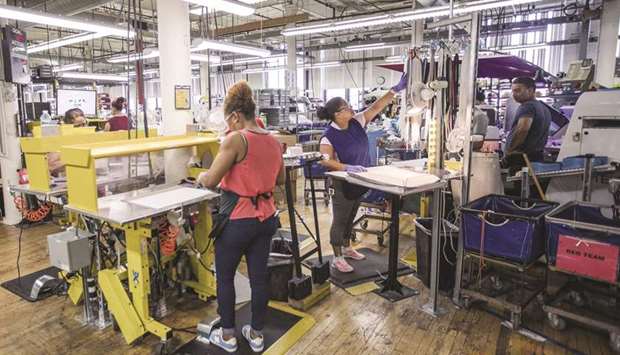New orders for long-lasting US-made goods fell for a second straight month in May as troubles at Boeing weighed on demand for aircraft, suggesting manufacturing could remain weak even as business spending on equipment appears to stabilise.
The report from the Commerce Department yesterday added to a raft of weak data on trade, consumer confidence, housing and employment growth that have indicated a sharp loss of momentum in economic activity in the second quarter.
The economy, which will celebrate a record 10 years of expansion next month, is losing speed amid an ebb in both business and consumer confidence in the wake of an escalation in trade tensions between the United States and China.
Momentum is also fizzling as the stimulus from last year’s $1.5tn tax cut package and more government spending fades.
The growing risks to the economy coupled with low inflation prompted the Federal Reserve to last week signal interest rate cut starting as early as July. “We see the potential for further weakness as the factory sector continues to face a confluence of headwinds including sluggish global growth, rising trade uncertainty, an inventory glut and Boeing’s travails,” said Lydia Bousur, a senior US economist at Oxford Economics in New York.
Orders for durable goods, items ranging from toasters to aircraft that are meant to last three years or more, dropped 1.3% last month after declining 2.8% in April, the government said.
Economists polled by Reuters had forecast durable goods orders would slip 0.1% in May.
Orders for transportation equipment tumbled 4.6% after diving 7.6% in April.
That reflected a 28.2% plunge in orders for non-defence aircraft.
Civilian aircraft orders plummeted 39.3% in April.
Boeing reported on its website that it had received no aircraft orders in May after getting orders for four planes in April.
The world’s largest plane maker has cut production of its fastest-selling MAX 737 jetliner, which was grounded in March following two fatal plane crashes in five months.
Deliveries of the plane have also been suspended, leading to a 1.4% drop in aircraft shipments in May.
Aircraft inventories surged 2.5% last month.
The problems at Boeing also are contributing to an undercutting of production at factories.
Manufacturing, which accounts for about 12% of the economy, is also being undermined by an inventory overhang, especially in the automobile industry, which has resulted in fewer orders being placed with factories.
Motor vehicles orders rebounded 0.6% in May, leaving the bulk of April’s 3.2% drop intact.
Slowing global growth and the lingering effects of the dollar’s strength last year against the currencies of the United States’ trade partners also are hobbling activity.
Overall durable goods shipments rose 0.4% and inventories increased 0.5% in May.
Unfilled durable goods orders fell 0.5%, the most since June 2016, pointing to continued weakness in manufacturing in the months ahead.
Regional manufacturing surveys have also weakened in June.
The dollar was largely flat against a basket of currencies, while US Treasury prices were trading lower.
Stocks on Wall Street rose.
There are some glimmers of hope for manufacturing.
Orders for non-defence capital goods excluding aircraft, a closely watched proxy for business spending plans, increased 0.4% last month amid increases in demand for machinery, and computers and electronic products.
These so-called core capital goods orders dropped 1.0% in April.
Shipments of core capital goods increased 0.7% last month after an upwardly revised 0.4% gain in the prior month. Core capital goods shipments are used to calculate equipment spending in the government’s gross domestic product measurement.
They were previously reported to have been unchanged in April.
Business spending on equipment contracted in the first quarter for the first time in three years.
Fed chairman Jerome Powell on last Wednesday acknowledged the weak business spending and said many policymakers “cited the investment picture and weaker business sentiment... as supporting their judgment that the risk of less favourable outcomes has risen.”
“While core capital goods orders suggest businesses are not fully retrenching as they await clarity on trade and contend with slowing growth abroad, equipment spending still looks set to contract this quarter,” said Sarah House, a senior economist at Wells Fargo Securities in Charlotte, North Carolina.
Slowing growth in the second quarter was also underscored by another report from the Commerce Department yesterday showing the goods trade deficit widened 5.1% to $74.5bn in May as an increase in imports offset a rise in exports.
Following the reports, the Atlanta Fed trimmed its GDP growth estimate for the second quarter by one-tenth of a percentage point to a 1.9% annualised rate.
The economy grew at a 3.1% rate in the first quarter, boosted by a spurt in exports and an accumulation of inventories.
Last month, imports of goods increased $7.8bn to $214.7bn, boosted by a surge in imports of motor vehicles, capital goods, industrial supplies and consumer goods.
Exports of goods rose $4.1bn to $140.2bn last month.
There were increases in exports of food, motor vehicles, consumer and capital goods.
The wider goods trade deficit will likely subtract from GDP growth in the second quarter.

Workers assemble sneakers at a manufacturing facility in Lawrence, Massachusetts.


